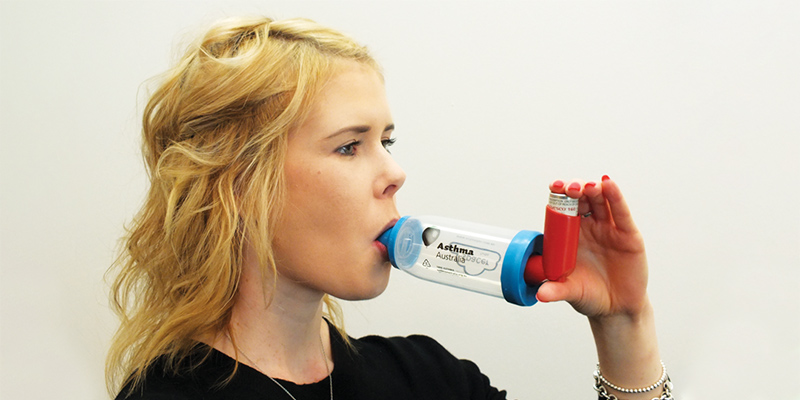Asthmatics failing to cough up for medicines, putting health at risk
By Candy Gibson
 HEALTH Research shows many Australians are under-using asthma treatments because of cost. Preventer inhalers (pictured) are different from reliever inhalers such as Ventolin. Photo courtesy Asthma Australia.
HEALTH Research shows many Australians are under-using asthma treatments because of cost. Preventer inhalers (pictured) are different from reliever inhalers such as Ventolin. Photo courtesy Asthma Australia.Half of all adults and a third of children with asthma are missing out on essential treatment due to out-of-pocket costs, a new Australian study has found.
A team of researchers led by The George Institute for Global Health and involving UniSA researcher Professor Libby Roughead, surveyed 1400 people with asthma, including adults and parents of children with asthma, about their medication use.
They found more than 50 per cent of adults and one-third of asthmatic children were guilty of decreasing or skipping doses to make medicines last longer or delaying filling a prescription.
In a paper published in the Journal of Allergy and Clinical Immunology, researchers say the results are especially concerning because about two-thirds of adults and children have poorly controlled asthma symptoms. Adults and asthmatic children who reported underuse have more asthma-related hospitalisations or incidents requiring urgent medical care.
“Asthma affects around one in nine Australians and is one of the world’s leading causes of death and disability,” says Prof Roughead, a medication expert from UniSA’s School of Pharmacy and Medical Sciences.
“We know that preventer inhalers can be incredibly effective at controlling symptoms and preventing people from being hospitalised or even from dying of asthma, yet our study has found that out-of-pocket costs are preventing Australians from accessing life-saving medicines.”
The most commonly prescribed preventer treatments for asthma contain inhaled corticosteroids (ICS) which, if taken regularly, reduce the severity of asthma and related deaths.
Senior Research Fellow Tracey-Lea Laba, from The George Institute, says unlike many other countries, Australia has a national medicines subsidy program through the Pharmaceutical Benefits Scheme (PBS), but most patients still have a co-payment.
“In Australia, patients with healthcare cards (pensioners, unemployed, single parents and people with a long-term disability) pay $6.50 per prescription. Everyone else – around 40 per cent of people with asthma – pays up to $40.30,” she says.
The study found that young male adults were the most likely to underuse asthma treatments. This is compounded by GPs being largely unaware that out-of-pocket costs are a huge concern for many of their patients, or that some preventers had lower out-of-pocket costs for patients than others.
Asthma Australia CEO Michele Goldman says if the prescribed treatment is not affordable, it’s not the right treatment.
“There are more affordable treatments on the market, perfectly suitable for most people with asthma,” Goldman says.
“I encourage GPs to put this top of mind and prescribe treatments suitable for each individual in front of them.”
Key findings
- 52.9 per cent and 34.3 per cent of parents reported under-using asthma treatments due to cost;
- Three quarters of children and adults had partly or poorly controlled asthma symptoms;
- About 40 per cent of adults with asthma had not used an ICS-containing medication in the previous year, despite Australian guidelines recommending that these should be taken by almost all adults with asthma;
- 45 per cent of adults and 64 per cent of children had required urgent healthcare treatment for their asthma in the previous year;
- While differences in income did not appear to be a driving factor in underuse, a sub-class of “working poor families” with asthmatic children was identified as having higher levels of underusing asthma medications.
The paper calls for urgent interventions to promote discussions between patients and their GPs about the cost of medicines, including the availability of lower cost preventative treatments.
The study was funded by the NHMRC, NPS MedicineWise and Asthma Australia and was a collaboration of The George Institute, The Woolcock Institute of Medical Research, University of NSW, University of Sydney and UniSA.
Other Stories
- Research reveals droughts becoming the norm in more of SA
- How to get the nutrients you need without eating as much red meat
- Asthmatics failing to cough up for medicines, putting health at risk
- Antidepressants and opioids double the risk of falls and fractures in older people
- From the Vice Chancellor
- Achievements and Announcements
- Exhibition honours a leader who shaped the nation – Bob Hawke
- 21st Century hedonism at MOD. asks … what’s your pleasure?
- How uni is helping Kyle in and beyond the pool
- Major breakthrough to help clean up toxic PFAS pollution
- Students to help defence personnel prepare for global sporting events
- Colombia defies old stereotypes during eye-opening study tour
- Fulbright researcher unpacks future learning
- The latest books from UniSA researchers
- MOD. Hedonism launch and National Reconciliation Week




